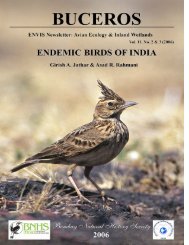Untitled - ENVIS Centre on Avian Ecology
Untitled - ENVIS Centre on Avian Ecology
Untitled - ENVIS Centre on Avian Ecology
Create successful ePaper yourself
Turn your PDF publications into a flip-book with our unique Google optimized e-Paper software.
ENDANGERED<br />
THREATENED BIRDS OF INDIA<br />
Buceros Vol. 7 & No. 1 & 2 (2002)<br />
apparently became extinct as a breeder in Morocco,<br />
central Europe and Israel in the twentieth century 1 . It<br />
breeds in western M<strong>on</strong>golia, and there are reports that it<br />
breeds in western China. Moreover, it is a n<strong>on</strong>-breeding<br />
visitor to Pakistan and (in very small numbers) to northern<br />
India. In India the species is a rare, very local and<br />
declining winter visitor to northern India, south to eastern<br />
Rajasthan and central Uttar Pradesh 2 . In 1997, <strong>on</strong>e bird<br />
was sighted in Amakhera Wetland in Aligarh district of<br />
Uttar Pradesh 6 .<br />
Populati<strong>on</strong>: The global populati<strong>on</strong> of the White-headed<br />
Duck was probably over 100,000 in the early twentieth<br />
century, falling to an estimated 19,000 birds in 1991,<br />
since when numbers have probably declined to fewer than<br />
10,000 individuals 3 .<br />
Main threats: Approximately 50% of breeding habitat<br />
has been drained during the 20 th century. Remaining sites<br />
22<br />
are vulnerable to polluti<strong>on</strong> 3 . Further threats include<br />
drowning in fishing nets, hunting, and ingesti<strong>on</strong> of lead<br />
shot 4 . Droughts in Kazakhstan may have caused recent<br />
poor breeding seas<strong>on</strong>s 4 .<br />
C<strong>on</strong>servati<strong>on</strong> measures: CITES Appendix II. CMS<br />
Appendix I. In India it is protected under the Wildlife<br />
(Protecti<strong>on</strong>) Act 1972 in Schedule IV: Anatidae. In<br />
Europe, a c<strong>on</strong>servati<strong>on</strong> programme in Spain has resulted<br />
in a significant populati<strong>on</strong> increase 4 . A European acti<strong>on</strong><br />
plan was published in 1996 5 .<br />
References: 1. Green and Anstey 1992; 2. Grimmett et<br />
al. 1998; 3. Green and Hunter 1996; 4. BirdLife<br />
Internati<strong>on</strong>al 2001; 5. Green and Hughes 1996; 6. M.<br />
Zafar-ul Islam (pers. comm. 2002).<br />
Note: No IBA site identified for this bird, but there is an<br />
unc<strong>on</strong>firmed record from Amakhera wetland in Aligarh<br />
district of UP.<br />
WHITE-WINGED DUCK Cairina scutulata Endangered A1c,d; A2c,d; C1; C2a<br />
Vulnerable D1<br />
This forest duck qualifies as Endangered because it has a very small, rapidly declining,<br />
severely fragmented populati<strong>on</strong> as a result of deforestati<strong>on</strong>, wetland drainage and<br />
exploitati<strong>on</strong>.<br />
Distributi<strong>on</strong>: The White-winged Duck was historically<br />
distributed widely from north-east India, through<br />
Bangladesh, Myanmar, Thailand, Laos, Vietnam,<br />
Cambodia and Malaysia, to the Ind<strong>on</strong>esian islands of<br />
Sumatra and Java. It now survives in relatively few<br />
scattered sites, having disappeared from many porti<strong>on</strong>s<br />
of its previous range. The species was “formerly<br />
widespread” in north-eastern India 1 , particularly in<br />
districts and states bordering the Brahmaputra river and<br />
its major tributaries 2,3 . It has been recorded from<br />
Arunachal Pradesh, Assam (mainly in the east and<br />
patchily elsewhere), Meghalaya, Nagaland and Manipur<br />
(no recent records from the latter two states), with its<br />
distributi<strong>on</strong> currently centred <strong>on</strong> the eastern lowlands of<br />
Assam and Arunachal Pradesh 4 . It has also been<br />
inc<strong>on</strong>clusively reported from Madhya Pradesh, Bihar,<br />
West Bengal and Tripura.<br />
Populati<strong>on</strong>: In 1992 the known wild populati<strong>on</strong><br />
(absolute minimum) was <strong>on</strong>ly 210, although few surveys<br />
had then been c<strong>on</strong>ducted 5 . This figure rose to an<br />
n n n<br />
estimated 336 so<strong>on</strong> afterwards 6 . After further survey<br />
work in India, Indochina and Ind<strong>on</strong>esia the most recent<br />
global populati<strong>on</strong> minimum is 450, comprising 130 in<br />
South-East Asia, 170 in India and Myanmar, and 150<br />
<strong>on</strong> Sumatra 7 . The minimum global populati<strong>on</strong> may now<br />
be 400, with the “true” figure probably in the regi<strong>on</strong> of<br />
“a few thousand, undergoing a c<strong>on</strong>tinuing decline” 8 .<br />
The Indian populati<strong>on</strong> is at 300–350, of which c. 200<br />
would be in the Tinsukia-Dibrugarh area, but still<br />
declining 4 .<br />
Main threats: Its decline is largely attributable to habitat<br />
loss, wetland drainage, hydropower development,<br />
protected area management problems, persecuti<strong>on</strong> and<br />
hunting, inbreeding, trade and captivity, disturbance,<br />
polluti<strong>on</strong> and pesticides, and natural predati<strong>on</strong>.<br />
C<strong>on</strong>servati<strong>on</strong> measures: It is in Schedule 1 of the Indian<br />
Wildlife (Protecti<strong>on</strong>) Act 1972. The species is listed under<br />
Appendix I of CITES and is legally protected from<br />
hunting and collecti<strong>on</strong> in seven countries: Bangladesh,




